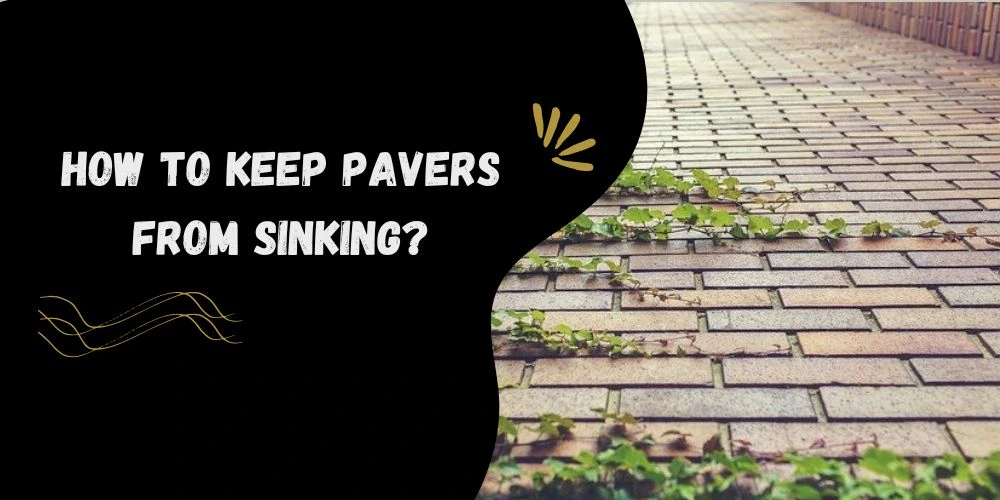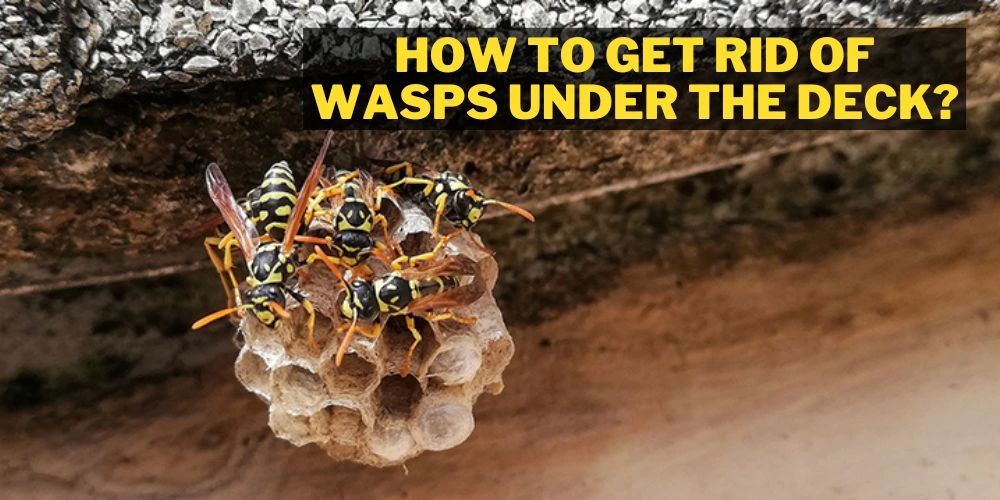Polymeric sand is a popular material used to fill the joints between pavers, providing stability and preventing weed growth. However, there may be instances when you need to remove polymeric sand from your pavers, such as when making repairs or replacing damaged pavers.
In this guide, we will discuss the process and techniques to help you understand how to remove polymeric sand from pavers?
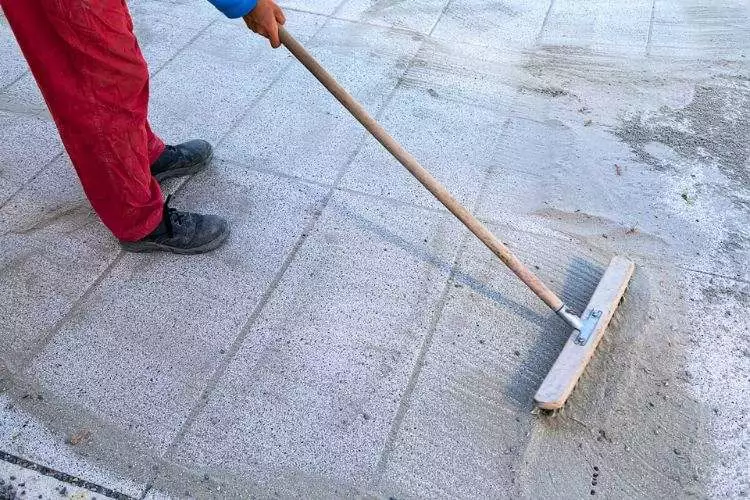
What tool removes polymeric sand from paver joints?
Several tools can be used to remove polymeric sand from paver joints. One of the most effective is a power washer, which uses high-pressure water to blast away the sand. This method is quick and efficient, but it can also be messy and may damage the pavers if not used carefully.
Another option is to use a polymeric sand remover, a chemical solution that dissolves the sand and makes it easier to remove. These products are typically applied to the affected area and left to soak for some time before being rinsed away with water.
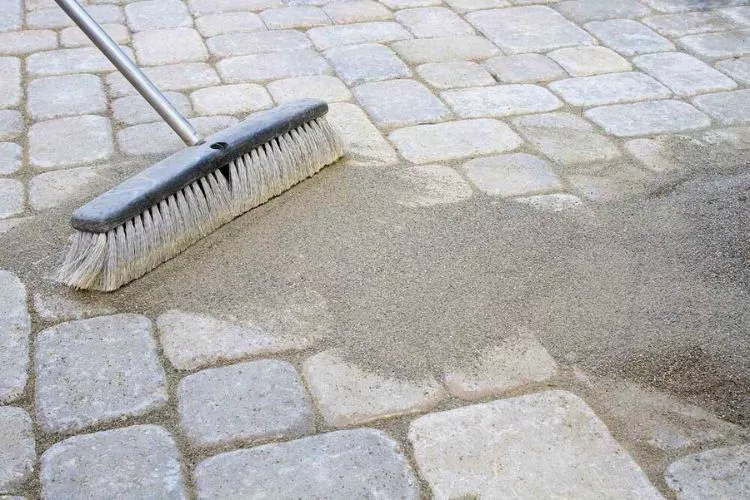
A third option is using a specialized tool called a polymeric sand extractor, designed specifically for removing polymeric sand from paver joints. This tool features a series of blades that scrape the sand out of the joints and can be adjusted to fit different joint widths.
How to remove polymeric sand from pavers after installation?
Removing polymeric sand from pavers after installation can be a tedious process. Still, it is necessary if there is excess sand on the paver surface or if the sand has not been set properly. Follow this step-by-step guide to effectively remove polymeric sand from your pavers.
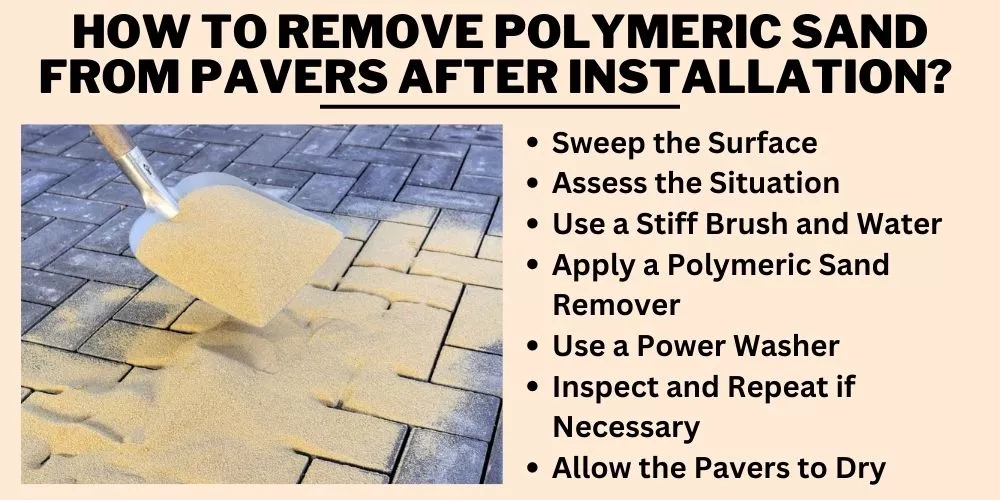
Step 1: Sweep the Surface
Before starting the removal process, sweep the surface of the pavers with a broom to remove any loose sand and debris. This will make it easier to identify the areas where polymeric sand needs to be removed.
Step 2: Assess the Situation
Determine the extent of the polymeric sand that needs to be removed. If there is only a thin layer of sand on the paver surface, you may be able to remove it using a brush and water. However, if the sand has hardened and formed a thick layer, you must use more aggressive methods.
Step 3: Use a Stiff Brush and Water
For a thin layer of polymeric sand, use a stiff brush and water to scrub the surface of the pavers. Be sure to apply enough pressure to break up the sand, but not so much that you damage the pavers. Rinse the area with water to wash away the loosened sand, and repeat the process until the sand is removed.
Step 4: Apply a Polymeric Sand Remover
If the sand has hardened and formed a thick layer, you must use a polymeric sand remover. Follow the manufacturer’s instructions for application, which typically involve applying the remover to the affected area, allowing it to soak for a specified period, and then rinsing it away with water.
Step 5: Use a Power Washer (Optional)
Sometimes, a power washer may be necessary to remove stubborn polymeric sand. However, use caution when using a power washer, as high-pressure water can damage the pavers. Keep the nozzle at least 12 inches from the paver surface and use a fan spray pattern to avoid concentrated pressure on a single point.
Step 6: Inspect and Repeat if Necessary
After completing the removal process, inspect the pavers to ensure that all polymeric sand has been removed. If sand is still present, repeat the necessary steps until the pavers are clean.
Step 7: Allow the Pavers to Dry
Once the polymeric sand has been removed, allow the pavers to dry completely before reapplying the new polymeric sand or using the area.
How To Remove Polymeric Sand After It Hardened?
Polymeric sand is a popular choice for filling the gaps between pavers and stones due to its durability, resistance to weeds, and ability to withstand harsh weather conditions. However, there might be instances when you need to remove hardened polymeric sand, whether due to improper installation or a change in design. Follow this step-by-step guide to remove hardened polymeric sand effectively and safely.
Step 1: Gather the Necessary Tools
Before starting the removal process, gather the following tools:
- Stiff-bristle brush or broom
- Plastic scraper
- Pressure washer or garden hose with a high-pressure nozzle
- Safety goggles
- Work gloves
- Dust mask
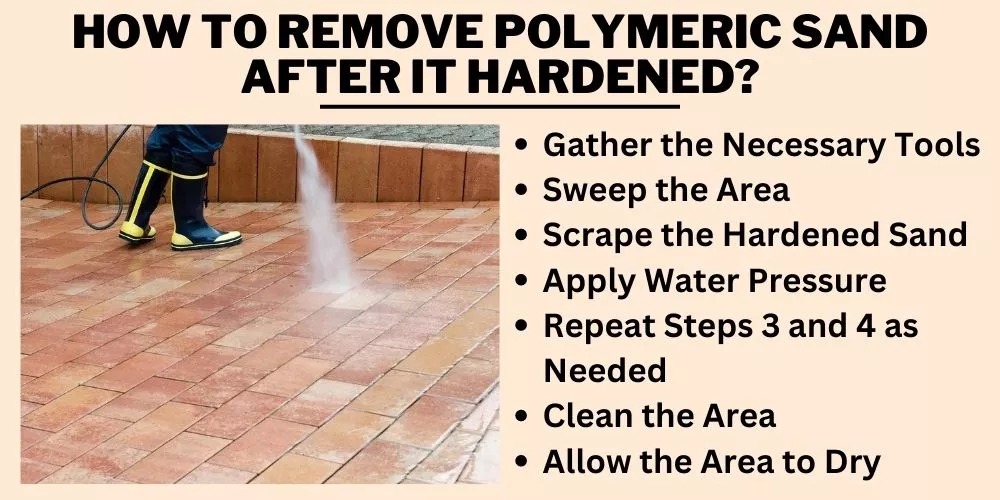
Step 2: Sweep the Area
Wearing your safety goggles, work gloves, and dust mask, use a stiff-bristle brush or broom to sweep the area, removing any loose sand or debris. This will help expose the hardened polymeric sand and make removing it easier.
Step 3: Scrape the Hardened Sand
Using a plastic scraper, carefully scrape away the hardened polymeric sand. Be cautious not to damage the pavers or stones during this process. If the sand is too hard to remove with the scraper, proceed to the next step.
Step 4: Apply Water Pressure
Apply water pressure to the hardened sand with a pressure washer or a garden hose with a high-pressure nozzle. Start from a distance and gradually move closer, focusing on the areas where the sand is the hardest. Be cautious not to damage the pavers or stones with the water pressure.
Note: If you’re using a pressure washer, follow the manufacturer’s instructions and safety guidelines.
Step 5: Repeat Steps 3 and 4 as Needed
Depending on the polymeric sand’s hardness and the area’s size, you may need to repeat the scraping and water pressure process several times to remove all the hardened sand.
Step 6: Clean the Area
Once the hardened polymeric sand has been removed, use the stiff-bristle brush or broom to clean the area again, removing any remaining sand or debris. If necessary, rinse the area with water to ensure it’s completely clean.
Step 7: Allow the Area to Dry
Allow the area to dry completely before applying new polymeric sand or proceeding with other work on the pavers or stones.
How do you remove dried polymeric sand from the top of the pavers?
Dried polymeric sand on the top of pavers can be unsightly and may cause damage over time. The following step-by-step guide will help you safely and effectively remove dried polymeric sand from the top of your pavers.
Step 1: Gather the Necessary Tools and Materials
Before starting the removal process, gather the following tools and materials:
- Stiff-bristle brush or broom
- Plastic scraper
- Pressure washer or garden hose with a high-pressure nozzle
- White vinegar or a paver cleaner solution
- Bucket
- Sponge or cloth
- Safety goggles
- Work gloves
- Dust mask
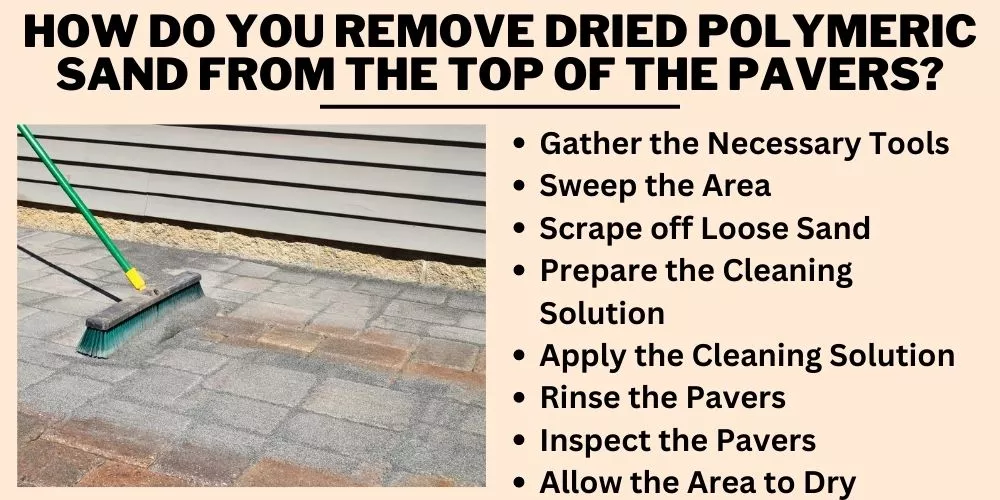
Step 2: Sweep the Area
Wearing your safety goggles, work gloves, and dust mask, use a stiff-bristle brush or broom to sweep the area, removing any loose sand or debris. This will make identifying and removing the dried polymeric sand on the pavers easier.
Step 3: Scrape off Loose Sand
Use the plastic scraper to carefully remove any loose or partially dried polymeric sand from the top of the pavers. Be gentle to avoid scratching or damaging the paver surfaces.
Step 4: Prepare the Cleaning Solution
Fill a bucket with a mixture of warm water and white vinegar, using a ratio of 1 part vinegar to 4 parts water. Alternatively, you can use a commercial paver cleaner solution per the manufacturer’s instructions.
Step 5: Apply the Cleaning Solution
Dip a sponge or cloth into the cleaning solution and gently scrub the dried polymeric sand on the pavers. Allow the solution to sit on the pavers for 5-10 minutes to help dissolve the sand.
Step 6: Rinse the Pavers
Using a pressure washer or a garden hose with a high-pressure nozzle, thoroughly rinse the pavers to remove the cleaning solution and any remaining polymeric sand. Be cautious not to damage the pavers with the water pressure.
Note: If you’re using a pressure washer, follow the manufacturer’s instructions and safety guidelines.
Step 7: Repeat Steps 5 and 6 as Needed
Depending on the severity of the dried polymeric sand on the pavers, you may need to repeat the cleaning and rinsing process several times to remove all the sand.
Step 8: Inspect the Pavers
Once you have completed the cleaning and rinsing process, carefully inspect the pavers to ensure that all the dried polymeric sand has been removed. If necessary, repeat the previous steps until the pavers are completely clean.
Step 9: Allow the Pavers to Dry
Allow the pavers to dry completely before applying new polymeric sand or proceeding with any other work on the pavers.
Will a pressure washer remove polymeric sand?
Yes, a pressure washer can remove polymeric sand, but it should be used cautiously to avoid removing the sand between the joints or causing damage to the pavers. It is recommended to use cold water when pressure washing polymeric sand, as warm water can warp the sand.
What Shall You Do After You Remove Polymeric Sand From Pavers?
After you have successfully removed polymeric sand from your pavers, it’s essential to follow certain steps to ensure the longevity and appearance of your pavers. Here’s what you should do:
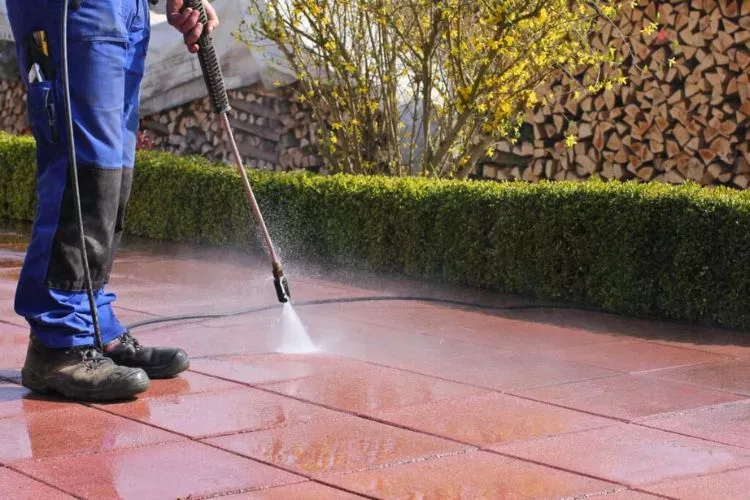
- Clean the pavers: Thoroughly clean the pavers using a stiff-bristle brush or broom to remove any remaining sand or debris. If necessary, rinse the area with water to ensure it’s completely clean. Allow the pavers to dry completely before proceeding to the next step.
- Inspect the pavers: Carefully examine the pavers for any damage or unevenness that may have occurred during the removal process. If you find any damaged pavers, consider replacing them to maintain the structural integrity of your paved area.
- Reapply polymeric sand: Once the pavers are clean and dry, you must reapply polymeric sand to the joints. Make sure to choose the right type of polymeric sand for your specific pavers and follow the manufacturer’s instructions for application. This typically involves pouring the sand onto the pavers, sweeping it into the joints, compacting it with a broom, and then lightly misting the area with water to activate the binding agent.
- Allow the sand to cure: Give the polymeric sand ample time to cure and harden according to the manufacturer’s recommendations. This usually takes between 24 to 48 hours. Avoid walking or driving on the pavers during this time to ensure proper curing.
- Seal the pavers (optional): If desired, you can apply a paver sealer to protect the pavers and polymeric sand from weathering, staining, and fading. Make sure to choose a sealer compatible with your pavers and follow the manufacturer’s instructions for application. Allow the sealer to dry completely before using the paved area.
- Regular maintenance: To keep your pavers looking their best, regularly sweep the area to remove dirt and debris, and address any emerging weeds. Periodically inspect the pavers and polymeric sand for signs of wear or damage, and perform any necessary repairs or maintenance.
Other Paver Related Article You May Find Useful: How to Keep Pavers From Sinking | Can You Put Deck Tiles On Grass
Frequently Asked Questions (FAQs)
Will hot water remove polymeric sand?
Hot water may help soften and remove polymeric sand, but it may not be as effective as a pressure washer or a cleaning solution. Also, hot water can potentially warp the sand, so cold water is recommended.
What chemical removes polymeric sand?
White vinegar is a common household chemical that can help remove polymeric sand when mixed with water in a 1:4 ratio. Alternatively, commercial paver cleaners specifically designed to remove polymeric sand can also be used.
Is polymeric sand permanent?
Polymeric sand is not permanent but is a long-lasting solution for filling joints between pavers. Over time it may need to be replaced or reapplied over time due to wear, erosion, or other factors. Regular maintenance and proper installation can help extend the lifespan of polymeric sand.
Conclusion:
Removing polymeric sand from pavers requires a careful approach and the right tools to ensure the pavers remain intact and undamaged. Following the step-by-step guides above regarding how to remove polymeric sand from pavers, you can effectively remove hardened or dried polymeric sand from your pavers. Once the removal process is complete, it’s essential to reapply polymeric sand and maintain your pavers regularly for a long-lasting, attractive outdoor space.

